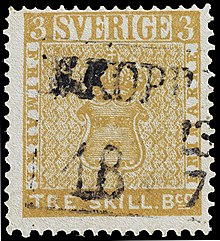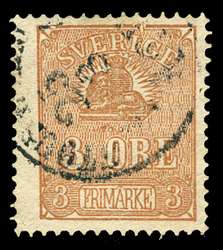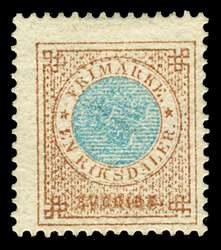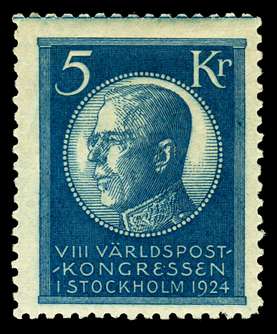 |
| The Treskilling Yellow Source: Wikipedia |
A printing error resulted in the Treskilling Yellow, a unique stamp that is currently the highest-priced in the world. Due to a printing error, this stamp is printed on yellow colored paper (meant for the eight skilling stamp of the same set) instead of the usual green color (used for the three skilling stamp). One copy of the yellow error variety of this stamp was found in 1885 by a young Swedish boy in his grandfather's collection. It is a one-of -a- kind rarity, as no other copies have been discovered to date. In 1996 the stamp was sold to an anonymous collector for $2.3 million at auction.
(The following is based on History of Swedish Stamps and Wikipedia - with some additions from The History of Swedish Stamps.)
In 1856 a black stamp for local mail followed. It had no value printed, but had a face value of 1 skilling banco. Also here a printing mistake is known. As the stamp is very regular, it is very easy to turn it up-side-down without taking any note of it. This happened during printing the stamp, and a so-called tete-beche was born.
New currency
 |
| Source |
In 1862 the local mail stamp was printed in brown, due to new rules who would receive the money.
A new design that included a reclining lion appeared in 1862, but it was used only for 3 öre, 17 öre, and 20 öre values
 |
| Source |
Although the "Lion type" stamps were already in circulation, the Ringtyp series was largely intended as a replacement for the Arms type ("Vapentyp") stamps that had been in use since Sweden's initial stamp issue in 1855.
(For an interesting collection of this issue see Ringtyp Stamps of Sweden)
The numeral issue included Sweden's first bi-colored stamp; the 1-riksdaler value was printed in bistre and blue, and the center design was the Three Crowns of the royal arms. The numerals continued in use for nearly twenty years, the main change being the replacement of the riksdaler stamp with a 1-kronor value in 1878 (five years after the introduction of krona).
 |
| Source: Wikipedia |
 |
| 1877 1 riksdaler Ringtyp Source |
Oscar II period
(The following year the practice began of printing a posthorn on the back of each stamp, underneath the gum - as described above.)
In 1889 a shortage of 10 öre values necessitated the surcharge of 12 öre and 24 öre numerals.
 |
| Source: Widipedia |
On 26 October 1903, Sweden's first commemorative stamp came out; a 5-kronor value depicting the Stockholm Post Office on the occasion of its opening.This stamp is twice the size of Oscar and printed in copper plate recess with a nice blue shade.
Gustaf V
When King Oscar II died in 1907 he was succeeded by Gustaf V. In 1911 new stamps in 20 and 25 öre were needed, but no stamps with the picture of Gustaf V were ready. The post office reprinted therfore these two Oscar stamps on paper with only watermark KPV in the sheet margins.
Additional surcharges were needed in 1918 before new stamps of the series could be printed.
1920 saw the introduction of coil stamps using a lion design and a new portrait of Gustav, along with a crown and posthorn design for larger denominations, as well as a commemorative depicting Gustavus Adolphus and marking the 300th anniversary of a precursor mail route that ran from Stockholm to Hamburg. These and subsequent Swedish issues were usually issued in both booklet (or sheet) and coil form. During the 1920s, the 1920 definitives were gradually supplanted by a new series with a 3/4 profile of Gustav.
 |
| Source |
In 1924, the Universal Postal Union celebrated its 50th anniversary and its Congress was held in Stockholm, so Sweden issued two series marking it, the first with a view of the Stockholm skyline, and the second with two designs; a postrider watching an airplane, and a carrier pigeon over a globe. Both sets were primarily aimed at collectors, but are nevertheless prized today.
No comments:
Post a Comment